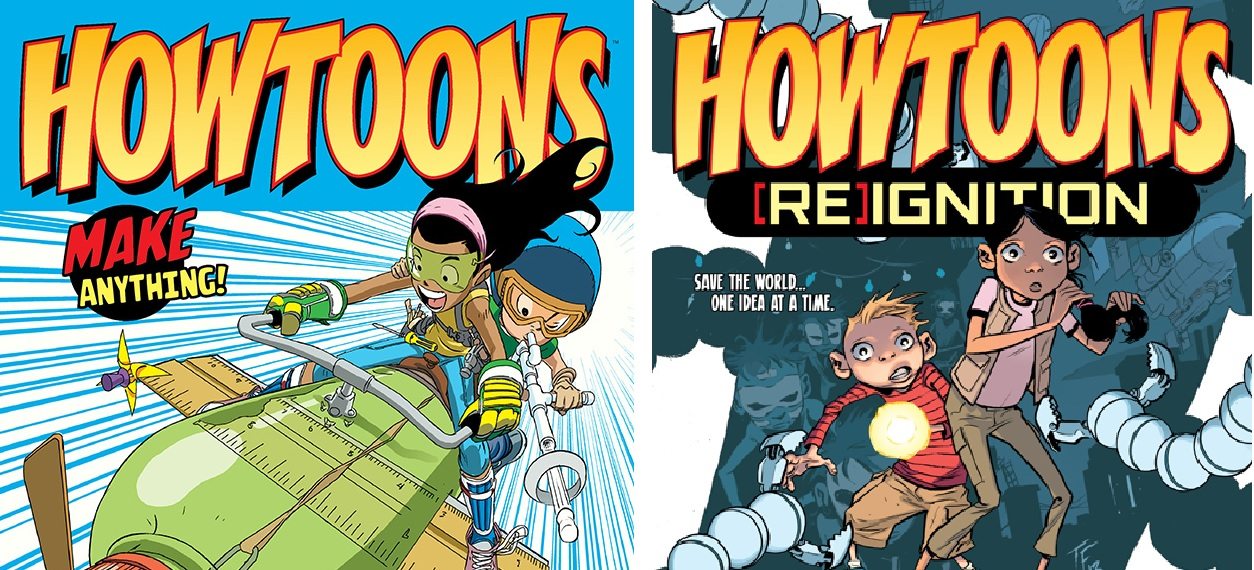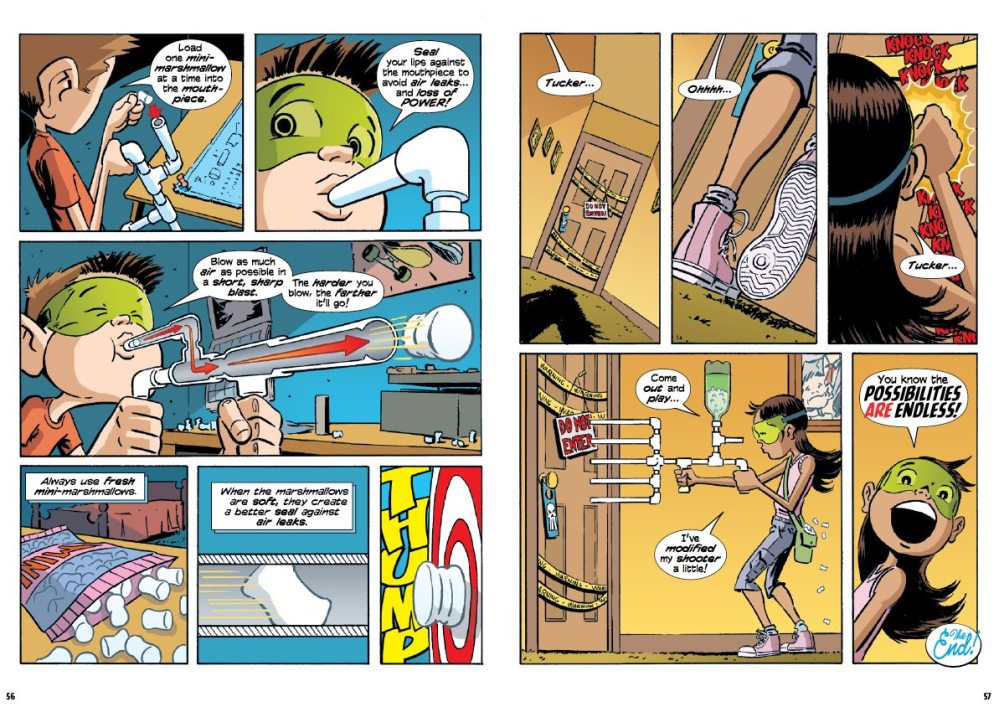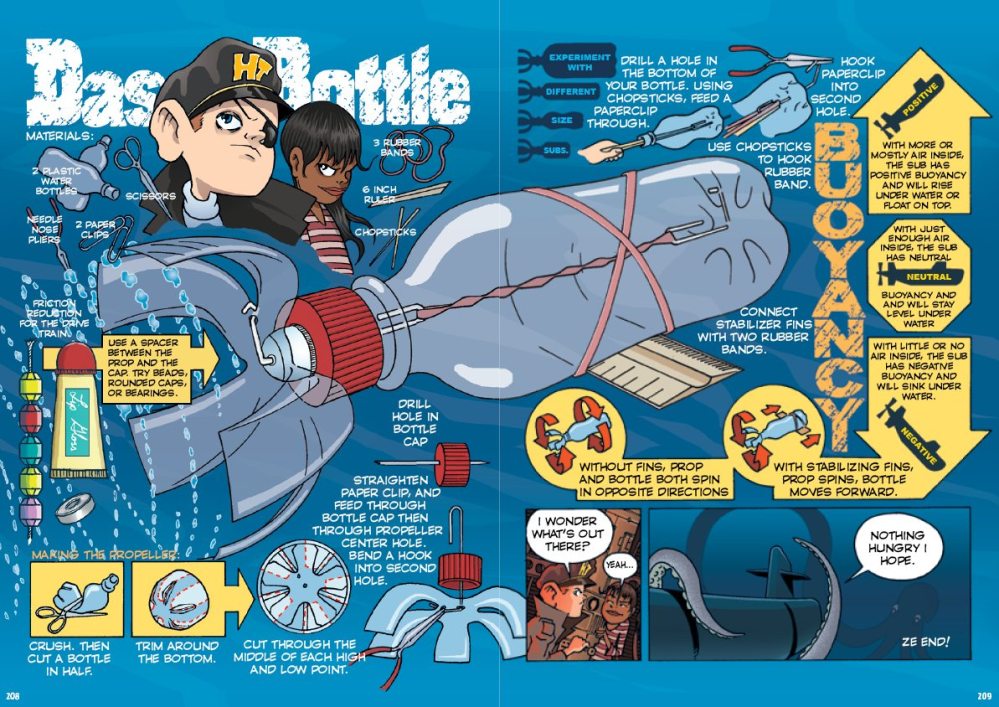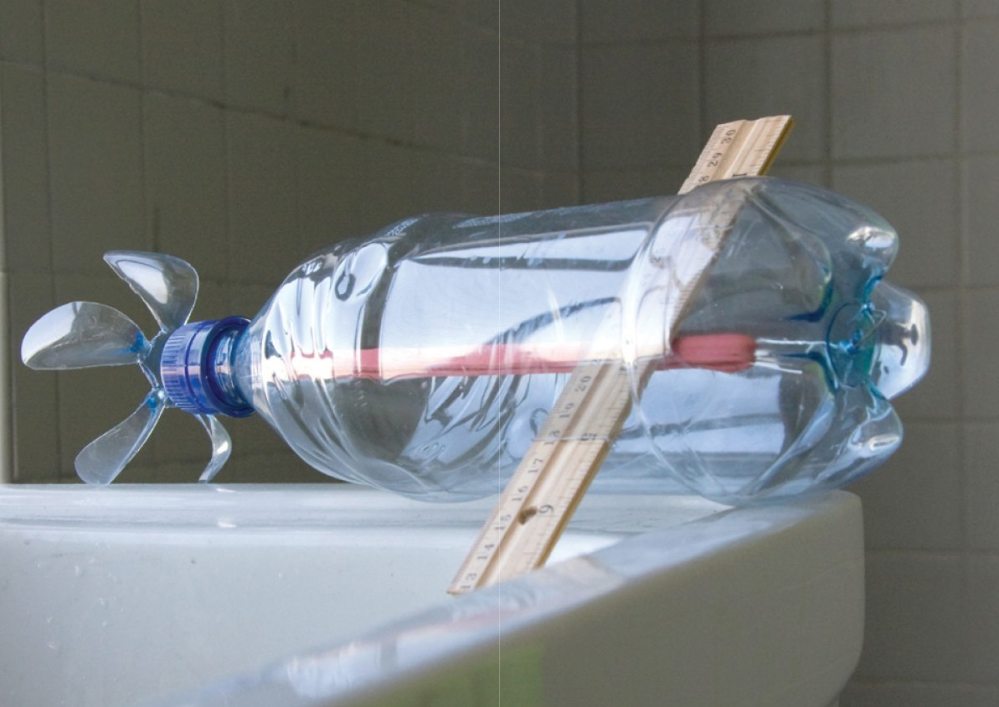Comics that aspire to be educational are not the easiest things to create. Well, I take that back; I guess they might be easy enough. There certainly are a lot of really bad “educational” comics out there. However, good comics that successfully educate and entertain are ridiculously hard to make.
If you’re skeptical that such a thing exists, I have two things to say to you. First, I don’t blame you. Second, I invite you to look no further than Howtoons (put out by Image Comics). Howtoons is the brainchild of artist Nick Dragotta and engineer/inventor Saul Griffith, and it aims to teach kids the fundamentals of math, science, and engineering through DIY projects that use everyday household materials.
Think Mr. Wizard in graphic novel form.
Step-by-step instructions for each project are in comic story form, and those instructions are sandwiched into a storyline that follows two siblings (Tucker and Celine) who make the projects themselves and go on adventures. The first collection (Howtoons: Tools of Mass Construction) is available now, and the second (Howtoons: [Re]Ignition) releases on February 25. Both are fantastic.
I had the chance to chat with artist Nick Dragotta—who is perhaps best known for his work on Image Comics’ East of West with Jonathan Hickman—about his work on Howtoons, getting kids interested in STEAM subjects, and how to make the world a better place.
GeekDad: Let’s start with an easy one. Why aren’t more elementary science textbooks like Howtoons? It seems like a no-brainer.
Nick Dragotta: I’d never presume to know more about teaching than a real teacher in the trenches. From the teachers I’ve talked to, I’d say it has a lot to do with the limits of time and the standards they have to meet. If material isn’t tailored to the criteria they have to meet, it’s hard to work it into a lesson plan. I do think comics can play a larger role in the classroom. I’m in love with the art form of comics. It speaks a kid’s language. Kids are drawn to cartoons. If we as designers do our job right, the drawings themselves can transcend language. Outside of just literacy, comics can be a very powerful teaching tool. It’s a great way to immediately display information on a page. Not to mention it’s a relatively cheap medium to produce.
GD: Here’s another softball: What’s the secret to getting more kids interested in STEM subjects?
ND: It’s all problem-solving and play. What’s not interesting about that? Show me a kid who doesn’t like a challenge. STEM topics are the ingredients that make it all happen. Science, technology, engineering, and math. We actually say STEAM, and like to add “Art.” The challenge for us is finding the problems our kids are passionate about. I’ve always thought about Howtoons as primer material. Let’s introduce kids into these heavy subjects lightly with comics that are so entertaining they have to get up off the couch and go live the adventure they just read. Let’s stoke imaginations and get them to learn through play.
I think we should actively seek and bring out passions in children they didn’t even know they had and cultivate them. My parents and school teachers sensed I liked art as a child and they nurtured it. Now I’m a professional comic book artist. I get to create; the work is in solving visual problems on paper. I get paid to practice my passion. Everyone should be so lucky.

GD: My own daughter is currently obsessed with science experiments. She has a few books of DIY projects with household objects and also just likes to tinker and mix stuff together. The format of Howtoons, though, really seemed to engage her at a deeper level than her other books. She was able to follow along with Tucker and Celine and then wanted to stop every couple of pages to start a new project. Through the narrative, she was able to see how each project had practical uses. Have you had the opportunity to take Howtoons on the road and into classrooms? Have you gotten a strong response from parents and teachers?
ND: Yeah, with our first book we actually did a book tour across the U.S. We were treated like rock stars. My partner Saul, who is a scientist/engineer, and myself, a comic book artist, visited these schools and just talked about our day-to-day jobs. We went in and showed them how to build marshmallow shooters, launch rockets across the gym, make farters, construct soda bottle subs, etc. It was cool opening them up to these ideas of looking at the world differently. We can make all this great stuff from just using everyday household goods and recycled trash.
I’d also draw live from challenges by kids in the audience. Saul would ask what the kids would like to invent and talk them through the practical applications of the invention, and I’d draw it. My favorite was the robotic cow with its four stomachs that would chew up dirty laundry, wash, rinse, dry, and poop out folded clean laundry. This girl had it all worked out. This cow would just graze her room and do her laundry.
GD: I think something that’s not stressed enough in classrooms is the idea of grit, or persistence—the idea that it’s okay to fail and that we learn from our failures. Is this something you think about at all when you’re working on a new project?
ND: I can’t avoid it. It’s part of my process, whether its Howtoons or East of West, it’s all trial and error. I’m constantly editing myself. So in that sense, I see the value of knowing I might not get it right the first time. I’m with ya; I see the frustration in my own boy when he can’t do something he sets out to do. I try and stress that we have to be open to failure and the process of learning from it. Happy accidents are the best. With that, it’s important to set goals or deadlines. This can force you to work at a fever pitch. No time for thinking—just do. Then step away and look back on it. I think the stuff from those experiences are great. It gets to that instinctual mode, rather than overthinking everything and trying to be perfect. Then there are times to slow it down, reassess. Name any great endeavor, and I guarantee there were many failures on the road to success. Also, we leave out important factors like the time it takes to learn or just having the right environment. Having a space to play, experiment, create.
GD: Talk to me about Howtoons [Re]Ignition. It’s more or less a spinoff series with different creators, right?
ND: [RE]Ignition was our attempt to make kids more energy literate. The project was based on Saul’s writings and presentations on better understanding how much energy we use as individuals and how we can conserve it. From there, it gets deeper into just how much energy is left on the planet, what are the sources, and what is the most abundant/smartest source moving forward. I’ve heard him give this talk many times, and it was inspiring yet scary as hell. Solving the problem of meeting the human population’s energy needs is either going to destroy us or save us. Sounds like a great plot for a comic.
We brought in a new creative team with Fred Van Lente (writer), Tom Fowler (artist), Jordie Bellaire (colorist), and Rus Wooton (letterer). This group is some of the best in the business. Ingrid Dragotta, my wife, who runs Howtoons on the day to day, edited the project and built and tested all the projects in the book. It’s such a complex subject, and I love how the creative team made something that looks at these dire problems in a smart positive way.
GD: I don’t want to get too political, but since it’s a theme in [Re]Ignition, I figure it’s fair game. Let’s talk a bit about the struggle of scientific literacy and the persistence of science denial in 2015, particularly with respect to climate change. How do you see this affecting kids, both today and in the future? Are there ways they can constructively engage in that debate?
ND: I don’t want kids to engage in a debate where one side is 99% proven and the other 1% is in denial. That debate is finished; let’s get to the solutions. I think we just have to be honest. Let’s frame it like this: Do you want to live on a clean planet or a dirty one? Should we strip-mine and hollow out the Earth for nonrenewable dirty sources of energy or cultivate and harness the cleaner renewable sources the sun, winds, and planet give us. We’re on the strip-mine track, and everything now seems so disposable, even the debates.
So much energy is used in our consumption. What if we taught kids about “embodied energy” through school supplies? Rather than buy disposable pens and discarding them only to buy more, we could buy one high-quality refillable pen that we take care of and will last us a lifetime. Yes, it takes more energy to make the refillable pen, but it’s been proven that choosing long-lasting quality uses energy more efficiently. We’re a culture of new, new, new—most of which is junk and not sustainable. Is this a good quality of life?
I love how Saul summed it up, “What it comes down to is being smart and aware of how energy is used everywhere in your life. The best way to get it right is to make decisions that make it easy to live an energy-efficient life. Live in a well-insulated house, close to the places where you work and play so you don’t have to transport yourself too far, too often, and eat healthy food from places that aren’t too far away.” If you ask me, that seems like a better quality of life than most.
GD: What’s next for the Howtoons gang? World domination?
ND: Just continue to improve the work. Bring more voices in. More artists, more STEM researchers, etc. We’d like to do a new book a year. Ingrid has some pretty cool ideas for making origami robots. That might be fun to draw.











